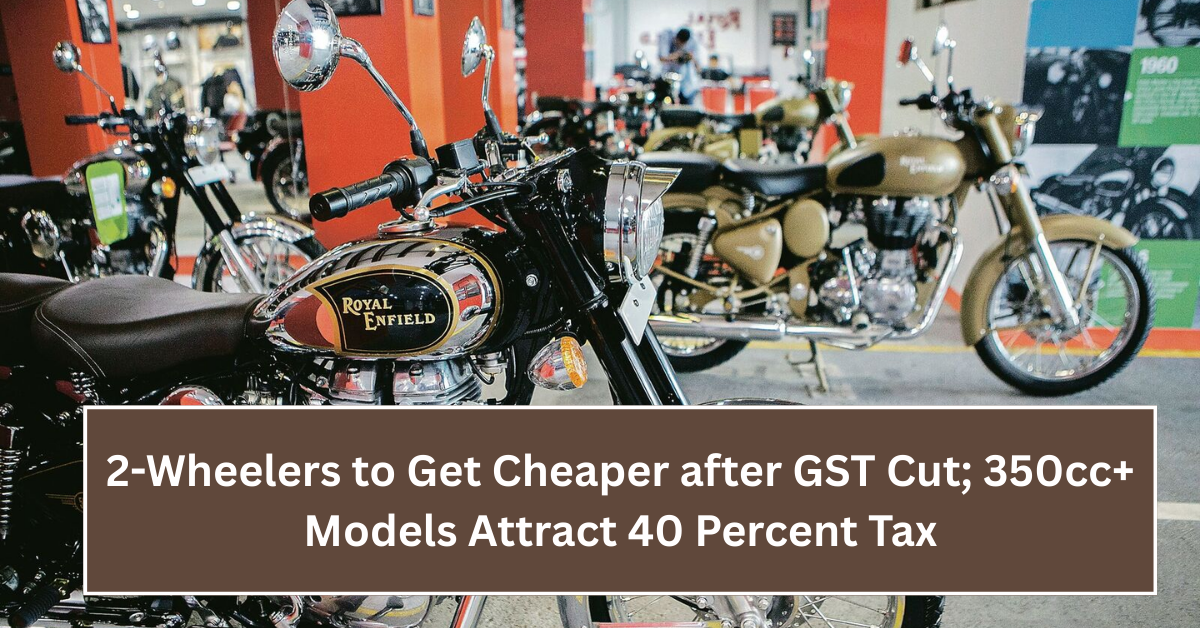The recent announcement of the Goods and Services Tax (GST) revision marks a significant shift in the 2-wheeler industry and for potential buyers across the country. As the government revises tax slabs, many commuters and bike enthusiasts can look forward to more affordable prices on smaller engine capacity bikes. This move is expected to boost sales, encourage greener transportation, and make bikes accessible to a broader demographic.
On the other hand, motorcycles with engine capacities above 350cc will now attract a higher tax rate of 40 percent, which will impact their price points and market dynamics. This differential tax structure aims to balance affordability while ensuring luxury and performance bikes bear a higher fiscal responsibility, indirectly promoting environmental considerations and road safety. Let’s dive deeper into the details, implications, and what buyers can expect moving forward.
The New GST Structure for 2-Wheelers Explained
Under the revised GST framework, 2-wheelers have been categorized based on engine capacity, altering the tax rates they attract. Bikes having engine displacements up to 350cc are now set to benefit from a reduced tax rate, making them more budget-friendly. Meanwhile, premium motorcycles with larger engines above the 350cc mark will face a 40 percent tax rate, reflecting a steeper fiscal burden.
This classification encourages manufacturers to develop more fuel-efficient and environmentally friendly models within the sub-350cc segment. The government’s objective appears clear: stimulate the purchase of practical daily commuters while discouraging excessive consumption of high-powered machines that might have higher emissions and fuel consumption.
How This GST Cut Benefits Buyers of Smaller 2-Wheelers
For buyers seeking economical and efficient transportation options, the GST reduction translates to genuine savings at the dealership. Prices of 125cc, 150cc, and other sub-350cc motorcycle models are expected to decrease substantially after the tax revision. This adjustment could also improve financing terms as lower prices reduce loan amounts and interest.
The reduction is likely to attract young riders, students, and first-time bike owners who prioritize affordability. Since these bikes typically offer better mileage and easier handling, this tax structure makes them even more appealing for daily commuting in urban and semi-urban settings. Additionally, the increase in affordability can spur demand, prompting manufacturers to launch new models with enhanced features.
Impact of the 40 Percent GST on Premium and Performance Bikes
While smaller bikes gain from tax relief, models equipped with engine capacities exceeding 350cc will see an increase in cost due to the 40 percent GST levy. This hike affects manufacturers, dealers, and end consumers of premium motorcycles, which include cruisers, sports bikes, and adventure models.
The higher tax not only raises the purchase price but may also influence insurance premiums and maintenance costs indirectly. Potential buyers might rethink their investment in high-displacement motorcycles or seek alternatives in the middleweight segment. Dealers could witness a slowdown in premium bike sales, although loyal customers may view this as a price adjustment rather than a prohibitive factor.
Expected Market Trends and Changes Post GST Revision
This GST revision is likely to lead to substantial shifts in the two-wheeler market. The affordable segment under 350cc could see heightened competition, as manufacturers strive to capture a larger share by introducing feature-rich and competitively priced models. Electric two-wheelers could also benefit, given rising environmental awareness and government incentives.
On the other hand, premium bike makers might explore alternative strategies such as localization of parts, enhanced financing offers, or even bundling services to cushion the higher tax impact. They may also focus on emphasizing luxury, performance, and brand prestige to justify pricing amid tougher tax conditions. Overall, the motorcycle market may evolve with more clear segmentation by engine capacity and customer needs.
Comparison of GST Rates by 2-Wheeler Engine Capacity
| Engine Capacity | Previous GST Rate | New GST Rate | Price Impact |
|---|---|---|---|
| Up to 350cc | 28 percent | 18 percent | Price reduction expected |
| Above 350cc | 28 percent | 40 percent | Price increase expected |
How This GST Change Encourages Sustainable Transportation
The tax structure aligning with engine capacity inherently promotes sustainability by favoring smaller, more fuel-efficient vehicles. Bikes with lower displacement generally consume less fuel and emit fewer pollutants. By making these more accessible through tax cuts, the government encourages commuters to transition to transport modes that are kinder to the environment.
Moreover, this approach dovetails with broader national goals for reducing urban pollution, managing traffic congestion, and cutting carbon footprints. It also stimulates innovation in the 2-wheeler segment, including the growth of electric bikes and hybrids, which often fall into sub-350cc categories and qualify for tax incentives.
Potential Challenges and Criticisms of the GST Adjustment
Despite the apparent benefits, this GST revision faces potential criticisms. Premium bike enthusiasts may see the increased tax as a deterrent, curbing the aspirations of some motorcycle lovers. Dealers could endure short-term sales fluctuations while customers re-evaluate purchase plans.
There is also a concern that the rise in tax for larger bikes might promote unregistered or black-market sales to evade high taxes. For manufacturers, increased taxation could reduce profit margins or slow investment into developing high-performance models domestically. Balancing these factors will be vital as the industry adapts to the new GST regime.
Advice for Buyers: How to Navigate the New GST Landscape
Potential 2-wheeler buyers should evaluate their needs carefully in light of the GST changes. Those looking for practical commuting options may find the reduced pricing on sub-350cc models particularly attractive. It’s advisable to research updated prices, check for new launches, and explore financing deals that have improved due to the tax cut.
For enthusiasts interested in premium motorcycles, it’s important to factor in the increased GST while negotiating with dealers. They may want to consider waiting for promotional periods or exploring used bike markets where price increments might be less severe. Additionally, keeping an eye on upcoming policy changes or incentives around electric and hybrid 2-wheelers can unlock better opportunities.
Conclusion: A New Era for 2-Wheeler Buyers and Market Dynamics
The recent GST revision reshaping tax rates for 2-wheelers signifies a move toward sensible, environmentally conscious transportation policies. With decreased taxes on smaller engines and increased rates for powerful models, buyers have clearer segments to choose from based on their lifestyle and budget. This dynamic encourages fuel efficiency, affordability, and innovation in the competitive motorcycle market.
While some may feel the pinch of higher prices in the premium segment, the overall industry is set to benefit from expanded consumer bases and evolving product portfolios. For young riders and daily commuters, this GST cut offers a welcome chance to own stylish, reliable 2-wheelers without straining their finances—ushering in a new wave of mobility across urban and rural landscapes alike.




